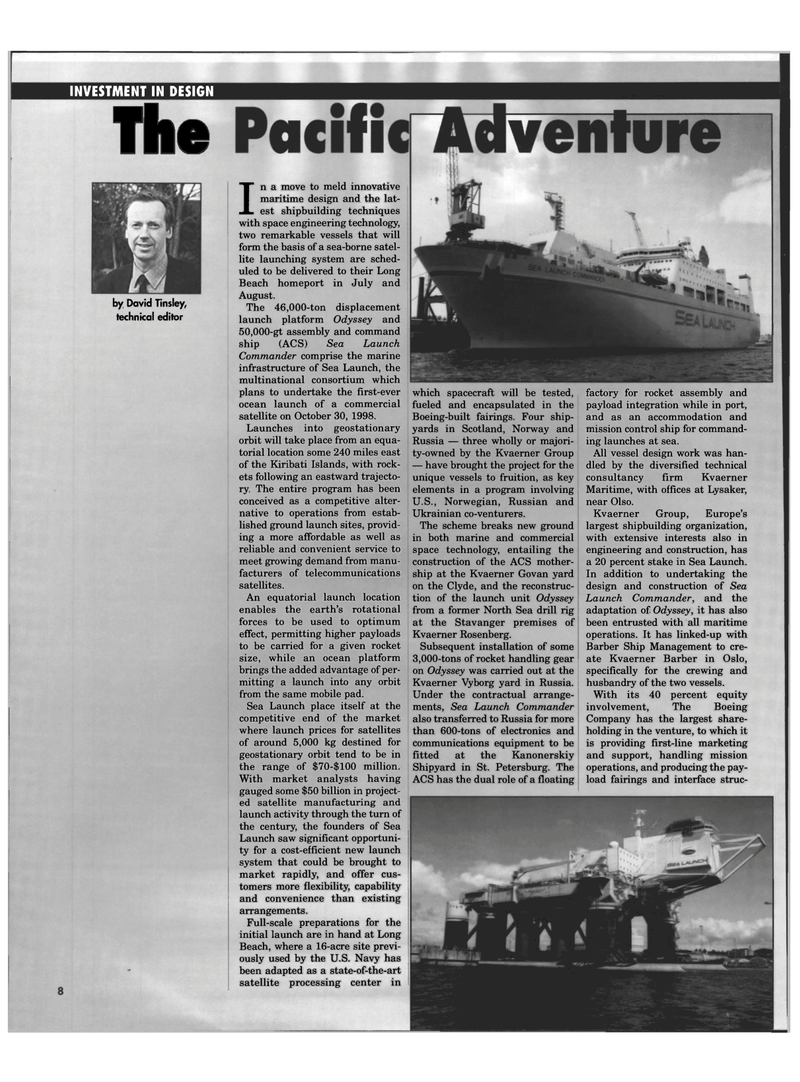
Page 8: of Maritime Reporter Magazine (July 1998)
Read this page in Pdf, Flash or Html5 edition of July 1998 Maritime Reporter Magazine
INVESTMENT IN DESIGN The by David Tinsley, technical editor factory for rocket assembly and payload integration while in port, and as an accommodation and mission control ship for command- ing launches at sea.
All vessel design work was han- dled by the diversified technical consultancy firm Kvaerner
Maritime, with offices at Lysaker, near Olso.
Kvaerner Group, Europe's largest shipbuilding organization, with extensive interests also in engineering and construction, has a 20 percent stake in Sea Launch.
In addition to undertaking the design and construction of Sea
Launch Commander, and the adaptation of Odyssey, it has also been entrusted with all maritime operations. It has linked-up with
Barber Ship Management to cre- ate Kvaerner Barber in Oslo, specifically for the crewing and husbandry of the two vessels.
With its 40 percent equity involvement, The Boeing
Company has the largest share- holding in the venture, to which it is providing first-line marketing and support, handling mission operations, and producing the pay- load fairings and interface struc-
In a move to meld innovative maritime design and the lat-est shipbuilding techniques with space engineering technology, two remarkable vessels that will form the basis of a sea-borne satel- lite launching system are sched- uled to be delivered to their Long
Beach homeport in July and
August.
The 46,000-ton displacement launch platform Odyssey and 50,000-gt assembly and command ship (ACS) Sea Launch
Commander comprise the marine infrastructure of Sea Launch, the multinational consortium which plans to undertake the first-ever ocean launch of a commercial satellite on October 30, 1998.
Launches into geostationary orbit will take place from an equa- torial location some 240 miles east of the Kiribati Islands, with rock- ets following an eastward trajecto- ry. The entire program has been conceived as a competitive alter- native to operations from estab- lished ground launch sites, provid- ing a more affordable as well as reliable and convenient service to meet growing demand from manu- facturers of telecommunications satellites.
An equatorial launch location enables the earth's rotational forces to be used to optimum effect, permitting higher payloads to be carried for a given rocket size, while an ocean platform brings the added advantage of per- mitting a launch into any orbit from the same mobile pad.
Sea Launch place itself at the competitive end of the market where launch prices for satellites of around 5,000 kg destined for geostationary orbit tend to be in the range of $70-$ 100 million.
With market analysts having gauged some $50 billion in project- ed satellite manufacturing and launch activity through the turn of the century, the founders of Sea
Launch saw significant opportuni- ty for a cost-efficient new launch system that could be brought to market rapidly, and offer cus- tomers more flexibility, capability and convenience than existing arrangements.
Full-scale preparations for the initial launch are in hand at Long
Beach, where a 16-acre site previ- ously used by the U.S. Navy has been adapted as a state-of-the-art satellite processing center in which spacecraft will be tested, fueled and encapsulated in the
Boeing-built fairings. Four ship- yards in Scotland, Norway and
Russia — three wholly or majori- ty-owned by the Kvaerner Group — have brought the project for the unique vessels to fruition, as key elements in a program involving
U.S., Norwegian, Russian and
Ukrainian co-venturers.
The scheme breaks new ground in both marine and commercial space technology, entailing the construction of the ACS mother- ship at the Kvaerner Govan yard on the Clyde, and the reconstruc- tion of the launch unit Odyssey from a former North Sea drill rig at the Stavanger premises of
Kvaerner Rosenberg.
Subsequent installation of some 3,000-tons of rocket handling gear on Odyssey was carried out at the
Kvaerner Vyborg yard in Russia.
Under the contractual arrange- ments, Sea Launch Commander also transferred to Russia for more than 600-tons of electronics and communications equipment to be fitted at the Kanonerskiy
Shipyard in St. Petersburg. The
ACS has the dual role of a floating

 7
7

 9
9
